Table of Contents
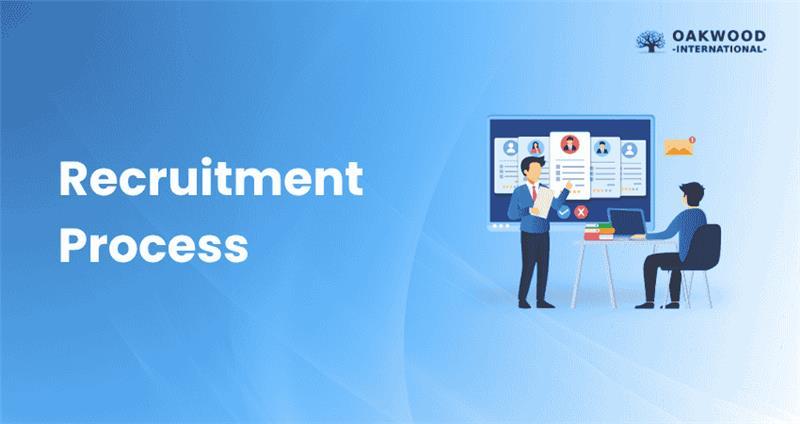

With the rise in competition and shifting skillset based on market demands, it can make finding the right candidate a challenge. This is why a structured Recruitment Process brings clarity during chaos. It enables you to find hidden talents, attract people who truly fit the role, and build a reliable stream of strong candidates.
In this blog, you will learn about the What is Recruitment Process, its crucial steps, benefits, tips and examples. So, whether you are an HR professional or a business owner, this blog will help you develop key recruitment strategies to ensure the success of the organisation. Let’s get started!
What is Recruitment?
Recruitment means discovering and attracting individuals to fulfil employment vacancies in an organisation. It is the process of identifying candidates with the appropriate skills, experience, and mindset for a role.
Recruitment is not just about filling a vacancy quickly but about choosing the best candidate who will help the company be successful. It is an important function in business because the workforce is a company’s most precious asset. A strong Recruitment Process supports this goal by ensuring the right people are hired at the right time.
What is Recruitment Process?
The Recruitment Process refers to the series of steps a company follows to identify, evaluate, and hire new employees. It begins with recognising the need for a new hire and ends when the chosen candidate accepts the job offer.
This process includes defining the job role, advertising the vacancy, reviewing applications, conducting interviews, and finalising the hiring decision. A well-structured Recruitment Process reduces hiring errors and ensures the right person is selected for the role.
Core Seven Steps in the Recruitment Process
A clear step-by-step Recruitment Process makes hiring more effective and efficient. The main steps include:
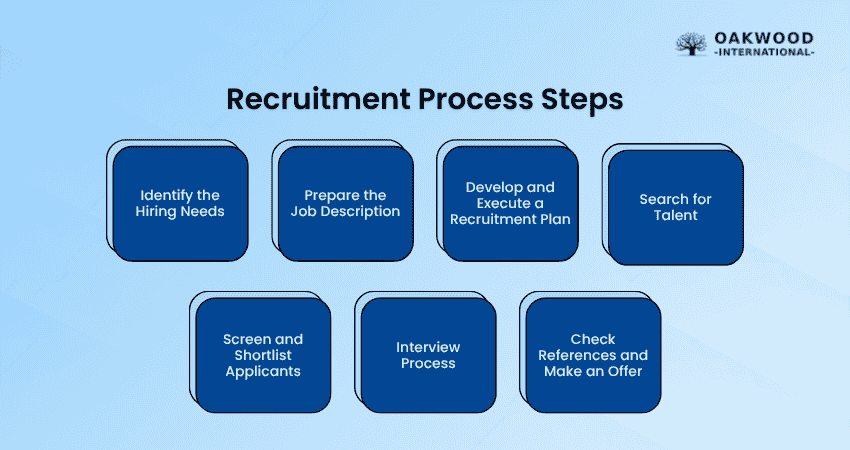
Step 1: Identify the Hiring Needs
Before starting the search, the organisation must clearly define the vacancy. This means understanding why the role is open, the tasks it includes, and the required skills and experience. Clarity at this stage ensures the rest of the process targets the right candidate profile.
Example: If a company requires a customer service executive to manage online queries, they must decide whether the role needs multilingual skills or experience with certain software tools.
Step 2: Prepare the Job Description
This is a detailed document that summarises the job title, responsibilities, qualifications, and required skills. It should be clear and specific to attract the right candidates. A strong job description also helps recruiters assess applicants more effectively.
Example: For a marketing specialist, the job requirement must include social media management, coordinating campaigns and analysing marketing data. Also, having key skills in digital marketing and communication.
Step 3: Develop and Execute a Recruitment Plan
Once the job description is ready, the organisation creates a recruitment plan. This outlines where to post the vacancy, how to promote it, timelines, budget, and who is responsible. The plan is then carried out by advertising the role and reaching out to candidates.
Example: A tech startup may post Software Developer jobs on GitHub and Stack Overflow and visit coding boot camps to find skilled Developers.
Step 4: Search for Talent
This involves actively looking for candidates by posting ads, using platforms like LinkedIn, attending job fairs, or encouraging referrals. Internal candidates may also be considered. A broader search improves the chance of finding top talent.
Example: A retail company might attend college career fairs to recruit part-time workers while also encouraging current employees to refer friends for open positions.
Step 5: Screen and Shortlist Applicants
After getting applications, recruiters look through resumes and cover letters to find those that fit the job. They check qualifications, experience, and skills to create a shortlist. Sometimes, they make quick phone or video calls to confirm basic information before inviting candidates for interviews. This step is important to the Recruitment Process.
Example: For an accounting job, candidates with certificates like ACCA or CPA might be shortlisted for interviews.
Step 6: Interview Process
Interviews help employers understand a candidate’s skills, experience, and personality. They can be one-on-one, with a panel, or in groups. Interviewers ask questions to understand if the candidate fits the job and the company. Some interviews include tests or tasks. Candidates also get a chance to ask about the job. A fair and consistent interview process is important.
Example: A customer support interview might include a role-play to check communication and problem-solving skills.
Step 7: Check References and Make an Offer
Before recruiting, it is usual to contact the last company or colleagues to verify candidates’ work history and performance. Once satisfied, the company gives a proper job offer, normally in writing. The offer involves compensation, benefits, job role, and start date. After acceptance, the Recruitment Process is complete, and onboarding starts.
Example: Before offering a management position, the hiring team contacts the last supervisors to confirm leadership abilities and work ethics.
Enhance your management with crucial HR skills. Join our HR Skills for Non-HR Managers Course now!
Benefits of an Effective Recruitment Process
A clear and ordered Recruitment Process offers many advantages to a company. It supports saving time, discovering the best candidate, and improving overall success. Let’s discuss a few key benefits:
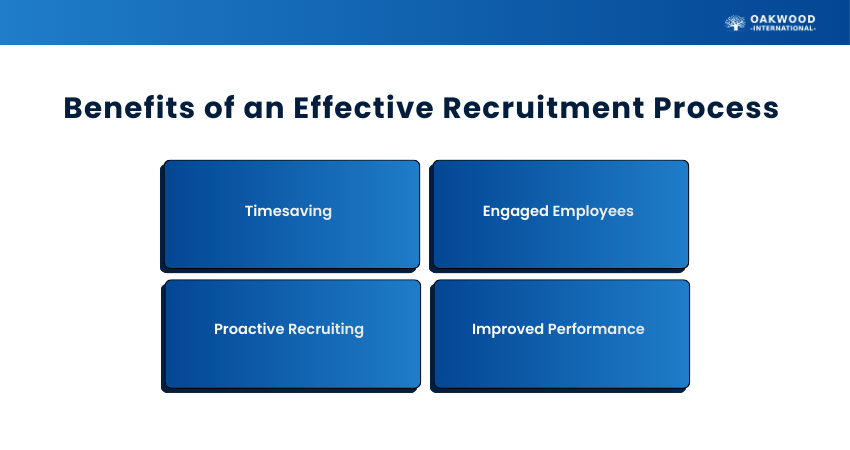
Timesaving
A transparent and organised Recruitment Process helps find the best candidate faster by focusing on suitable applicants and avoiding unwanted delays. This reduces the time spent on reviewing unqualified applicants and speeds up decision-making.
Engaged Employees
Hiring candidates who fit well with the role and company culture leads to greater job satisfaction, motivation, and loyalty. Engaged employees tend to continue longer, reducing turnover and training costs. A strong Recruitment Process supports this by ensuring a good match between the candidate and the company.
Proactive Recruiting
Planning recruitment ahead helps companies build relationships with potential candidates even before vacancies arise. This ensures a ready talent pool and reduces the pressure of urgent hiring needs, making the Recruitment Process more effecient and less stressful.
Improved Performance
Choosing the right people improves team effectiveness, innovation, and overall business success. Skilled and motivated employees contribute new ideas and help the organisation reach its goals. Making the Recruitment Process more effective and less stressful.
Elevate your career through advanced HR Analytics techniques with our HR Analytics Course – Join now!
Tips for Effective Recruitment Process
As the hiring process keeps evolving, organisations must adopt smarter and practical approaches to stand out. Let’s look at some key tips for helping you during the Recruitment Process.
1) Create a Positive Candidate Experience
Keep the Recruitment Process smooth, transparent and respectful. This helps to provide the applicants with a good, positive experience, even those who do not get selected. It helps to build a strong employer brand and encourages referrals.
2) Strengthen the Off-boarding Process
When employees leave the company on good terms, they tend to recommend your company to other future potential candidates. This positive off-boarding increases the chance of referrals and can bring past employees back as boomerang.
3) Offer a Flexible Working Arrangement
As workplaces evolve, providing remote and hybrid options is highly sought after by modern candidates. By highlighting flexibility, you can help attract skilled and motivated applicants.
4) Embrace Diversity
By embracing diversity in the Recruitment Process, you welcome candidates from different backgrounds and perspectives. This expands the talent pool, enabling the bringing of diverse ideas, improving collaboration and overall workforce performance.
Positive Recruitment Process Examples
A positive Recruitment Process is transparent, fair, and respectful to candidates while meeting business needs. It creates a good experience that encourages talented people to join.
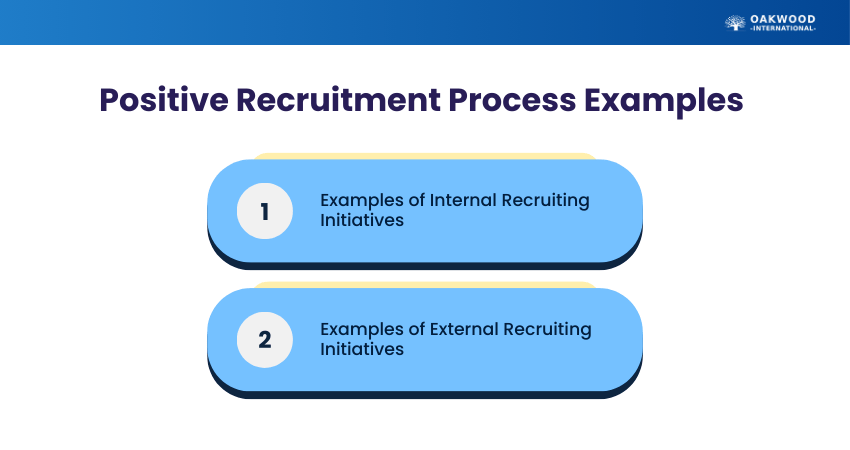
Examples of Internal Recruiting Initiatives
a) Employee Referrals: Employees recommend friends or contacts they believe are a good fit for the company. This often speeds up hiring and improves cultural fit because employees refer people they trust.
Example: Companies may offer referral bonuses to encourage employees to recommend qualified candidates, rewarding them if the person is hired and stays for a set period. Making the Recruitment Process more effective and less stressful.
b) Internal Job Postings: Vacancies are shared only within the organisation first, giving current employees a chance to apply. This supports career growth and helps retain talent by showing employees they have advancement opportunities.
Example: A company might post job openings on its internal website or bulletin board before advertising externally, encouraging internal movement.
c) Succession Planning: Organisations prepare employees to take on higher or critical roles through training and mentoring. This ensures the company has skilled staff ready to fill key positions when needed.
Example: High-potential employees receive leadership training or take part in job rotations to gain experience for future promotion, supporting a sustainable Recruitment Process.
d) Job Rotation Programs: Employees work in different departments or roles temporarily to develop new skills and discover where they fit best.
Example: A sales team member may spend time in the marketing department to learn more about the business, preparing them for leadership roles and later supporting a sustainable Recruitment Process.
e) Talent Pools: Human Resource (HR) maintains a list of employees interested in new roles so they can be contacted quickly when positions open, speeding up recruitment and improving fit.
Example: When a Project Management role becomes available, HR reaches out to employees who previously expressed interest, avoiding a lengthy external search and improving the efficiency of the Recruitment Process.
Examples of External Recruiting Initiative
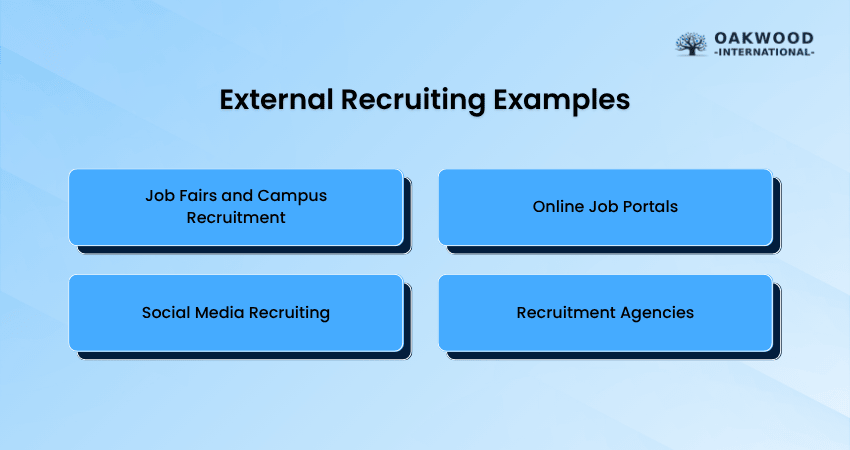
a) Job Fairs and Campus Recruitment: Meeting candidates face-to-face at universities or industry events helps companies find fresh talent and promote their brands.
Example: A company attends university career fairs to connect with recent graduates and offer internships or entry-level jobs.
b) Online Job Portals: Posting job openings on popular websites reaches a wide audience quickly and attracts diverse applicants.
Example: A business posts vacancies on sites like Indeed or Glassdoor to get applications from across the country or globe.
c) Social Media Recruiting: Using platforms like LinkedIn, Twitter, or Facebook to share job advertisements and connect with potential candidates, including passive job seekers.
Example: Recruiters use LinkedIn to search for professionals with specific skills and message them directly about job opportunities.
d) Recruitment Agencies: Cooperating with agencies that focus on discovering applicants for industries or jobs accelerates recruiting and enhances applicant quality.
Example: A company hires a recruitment firm specialising in IT to find qualified Software Developers quickly.
Conclusion
A well-ordered Recruitment Process is crucial to creating a strong, skilled employee. It helps companies invite and select the best talent. It also helps to save time and resources while enhancing employee comfort and production. If using internal or external approaches, keeping hiring honest, clear, and arranged with business targets will help to achieve good hiring results.
Advance your HR career by learning proven leadership strategies through HR Leadership Courses – Join today!


 Back
Back



 Back to Catagories
Back to Catagories





 + 44 7452 122728
+ 44 7452 122728










